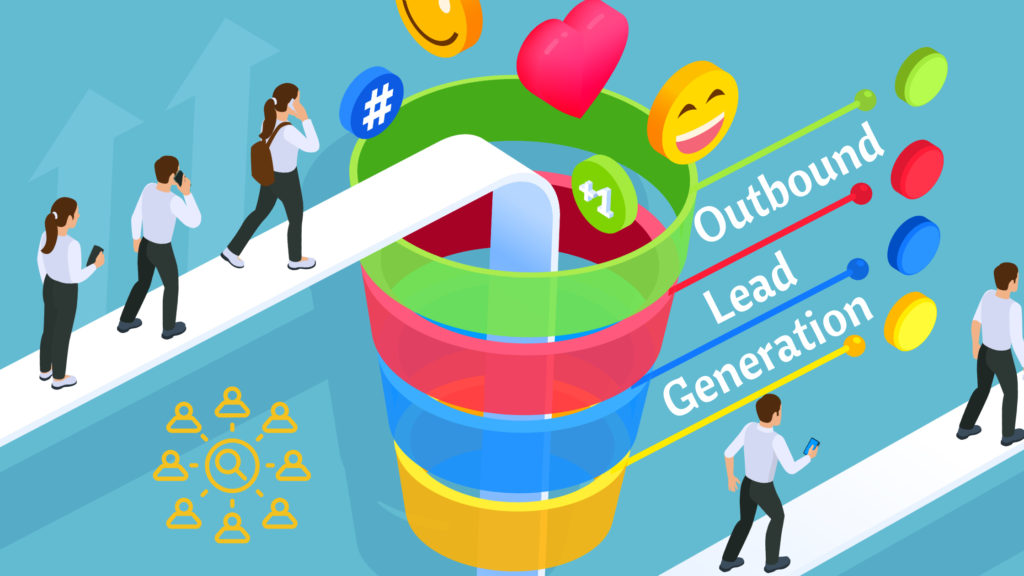Introduction To Outbound Lead Generation
In the dynamic world of business, generating leads is crucial for growth and sustainability. Outbound lead generation, in particular, plays a pivotal role in directly reaching out to potential customers. But what exactly is outbound lead generation, and why is it so important? Let’s dive deep into this topic and explore the strategies, tools, and techniques that can drive your business forward.

What is Outbound Lead Generation?
Outbound lead generation is the proactive process of identifying and reaching out to potential customers who may not yet be aware of your product or service.
Unlike inbound lead generation, which focuses on attracting customers through content and engagement, outbound lead gen involves direct outreach such as cold calling, email campaigns, and social media interactions.
Why Outbound Lead Generation Matters?
Outbound lead generation matters because it allows businesses to take control of their growth. Instead of waiting for customers to find you, you can actively pursue them. This approach often yields immediate results and provides direct feedback, enabling you to quickly adapt and refine your strategies.
Here’s why it matters:
- Proactive Customer Engagement: Outbound lead generation involves actively reaching out to potential customers rather than waiting for them to find you. This proactive outbound automation approach can help you quickly build relationships and fill your sales pipeline.
- Targeted Outreach: With outbound strategies, you can specifically target the ideal customer profiles and decision-makers within organizations. This precision ensures that your efforts are focused on individuals or companies most likely to be interested in your product or service, increasing the chances of conversion.
- Immediate Feedback and Adaptation: Engaging directly with prospects allows for immediate feedback. Sales teams can quickly gauge interest, objections, and potential pain points, which can then be used to refine pitches and strategies in real-time.
- Brand Awareness and Recognition: Even if initial outreach doesn’t lead to an immediate sale, it helps in building brand awareness. Repeated exposure to your brand can make prospects more likely to consider your offerings in the future.
- Scalability: Outbound lead generation efforts can be scaled up or down based on business needs. Companies can adjust their strategies and resources in response to market conditions, campaign performance, or sales goals.
Understanding Outbound vs. Inbound Leads
Definition of Inbound Leads
Inbound leads are those that come to you through various channels such as your website, social media, or content marketing efforts. These leads have shown interest in your product or service and are generally more informed about your offerings.
Key Differences Between Inbound and Outbound Leads
The primary difference lies in the approach: inbound leads are generated through attraction and engagement, while outbound leads are generated through direct outreach. https://seocompanyuae.net/google-ads-agency-dubai/
Inbound and outbound leads differ significantly in their origins, methods of acquisition, and the overall approach to engaging potential customers. Here are the key differences:
1. Origin of Leads
- Inbound Leads: These leads are generated when potential customers initiate contact with the company. They come to you, typically through content marketing, social media, SEO, or other inbound marketing efforts.
- Outbound Leads: These leads are generated through proactive outreach by the company. This involves the company reaching out to potential customers through methods like cold calling, direct mail, email campaigns, and paid advertising.
2. Method of Acquisition
- Inbound Leads: Acquisition relies on creating valuable content and experiences that attract potential customers to your website or social media platforms. Examples include blog posts, webinars, whitepapers, and search engine optimization (SEO).
- Outbound Leads: Acquisition involves direct engagement with potential customers through various outbound strategies. Examples include telemarketing, email marketing, direct mail, and paid ads.
3. Customer Intent
- Inbound Leads: These leads generally have a higher intent to purchase because they have actively sought out information or solutions related to your offerings. They are often more informed about your product or service.
- Outbound Leads: These leads may not have shown prior interest in your product or service and may require more effort to educate and convince. Their intent is generally lower compared to inbound leads.
4. Engagement Approach
- Inbound Leads: The approach is more passive and educational. It focuses on building trust and providing value through informative content that addresses the needs and pain points of potential customers.
- Outbound Leads: The approach is more aggressive and direct. It aims to capture attention quickly and persuade potential customers to consider your product or service, often through personalized and targeted messaging.
5. Cost and ROI
- Inbound Leads: Typically, inbound marketing has a lower cost per lead over time because it leverages organic growth and content that can continue to attract leads long after it’s created. The ROI can be higher in the long run due to the sustainability of content.
- Outbound Leads: Outbound marketing often involves higher upfront costs due to expenses related to advertising, purchasing contact lists, and direct outreach efforts. The ROI might be lower compared to inbound methods, but it can produce quicker results in terms of lead generation.
Creating Outbound Leads
Creating outbound leads requires a strategic approach. Here’s how you can get started:
Identifying Target Audience
The first step is to identify who your ideal customers are. This involves researching and understanding the demographics, interests, and pain points of your target audience.
Developing a Value Proposition
Your value proposition should clearly communicate the benefits of your product or service. It should address the needs of your target audience and differentiate you from competitors.
Crafting Effective Messaging
Your messaging should be clear, concise, and compelling. It should resonate with your audience and encourage them to take action.
Role of Outbound B2B Lead Generation
Outbound lead generation is especially crucial in B2B markets. It helps businesses build relationships with other companies, establish trust, and ultimately drive sales. Common techniques include:
- Cold calling
- Email marketing
- Networking
- Direct mail campaigns
How to Create an Outbound Strategy
Creating a successful outbound strategy involves several key steps:
Steps to Develop an Outbound Strategy
- Set Clear Goals and Objectives: Define what you want to achieve with your outbound efforts. This could be increasing sales, growing your customer base, or entering new markets.
- Choose the Right Channels: Select the most effective channels for reaching your target audience. This could include phone calls, emails, social media, or direct mail.
- Develop Your Messaging: Craft messages that resonate with your audience and compel them to take action.
- Train Your Team: Ensure your sales and marketing teams are well-equipped to execute the strategy.
Building a Target Audience Profile
To effectively reach your audience, you need to build a detailed profile of your ideal customer. This involves:
Defining the Ideal Customer Profile
Identify the characteristics of your best customers, such as industry, company size, job titles, and challenges they face.
Using Data and Analytics
Leverage data and analytics to refine your customer profiles and better understand their behaviors and preferences.
Developing a Value Proposition
Your value proposition should be at the core of your outbound efforts. It should:
Crafting a Compelling Offer
Offer something of value that addresses the specific needs and pain points of your target audience.
Aligning the Proposition with Customer Needs
Ensure your value proposition is aligned with what your customers are looking for. This will make your outreach efforts more effective.
Crafting Effective Messaging
Effective messaging is crucial for outbound lead generation. Here’s how to craft messages that work:
Key Elements of a Persuasive Message
- Clear and Concise: Keep your messages short and to the point.
- Compelling: Highlight the benefits of your product or service.
- Actionable: Include a clear call to action.
Personalization and Relevance
Personalize your messages to make them more relevant to each recipient. Use their name, mention their company, and address their specific needs.
Outbound Lead Generation Techniques
There are several techniques you can use for outbound lead generation:
Cold Calling
Cold calling involves reaching out to potential customers by phone. It’s a direct and personal way to engage with prospects.
Email Marketing
Email marketing allows you to reach a large audience with personalized messages. It’s cost-effective and can be highly targeted.
Social Media Outreach
Use social media platforms to connect with potential customers. This can include LinkedIn for B2B lead generation or other platforms depending on your audience.
Direct Mail
Direct mail can be an effective way to reach potential customers with tangible, personalized messages.
Tools and Technologies for Outbound Lead Generation
To streamline your outbound lead generation efforts, consider using these tools:
CRM Systems
Customer Relationship Management (CRM) systems help you manage and track interactions with potential customers.
Email Marketing Platforms
Email marketing platforms allow you to automate and personalize your email campaigns.
Lead Generation Software
Lead generation software can help you identify and reach out to potential customers more efficiently.
Measuring Success in Outbound Lead Generation
To ensure your outbound efforts are successful, you need to measure and analyze your results:
Key Metrics to Track
- Response Rate: The percentage of people who respond to your outreach.
- Conversion Rate: The percentage of leads that convert into customers.
- ROI: The return on investment of your outbound lead generation efforts.
Analyzing and Optimizing Performance
Regularly analyze your performance data to identify areas for improvement and optimize your strategies.
Challenges and Solutions in Outbound Lead Generation
Outbound lead generation comes with its own set of challenges. Here’s how to overcome them:
Common Challenges
- Finding the Right Prospects: It can be difficult to identify the right people to reach out to.
- Getting Past Gatekeepers: Reaching decision-makers can be challenging.
- Maintaining Engagement: Keeping potential customers engaged throughout the sales process.
Effective Solutions
- Use Data and Research: Leverage data to find the right prospects and understand their needs.
- Be Persistent: Don’t give up after the first attempt. Follow up and try different approaches.
- Provide Value: Ensure your outreach offers real value to your prospects.
Conclusion
Outbound lead generation is a powerful strategy for driving business growth. By understanding the differences between outbound and inbound leads, creating a targeted strategy, and using the right tools and techniques, you can effectively reach and convert potential customers. Remember to measure your success and continuously optimize your efforts to achieve the best results.
FAQs
What is the difference between outbound and inbound lead generation?
Outbound lead generation involves proactive outreach to potential customers, while inbound lead generation focuses on attracting customers through content and engagement.
How can small businesses benefit from outbound lead generation?
Small businesses can benefit from outbound lead generation by directly reaching out to potential customers, building relationships, and generating immediate interest in their products or services.
What are the best tools for outbound lead generation?
Some of the best tools include CRM systems, email marketing platforms, and lead generation software.
How do you measure the success of an outbound lead generation campaign?
Success can be measured by tracking key metrics such as response rate, conversion rate, and ROI.
What are some common mistakes to avoid in outbound lead generation?
Common mistakes include not researching your prospects, using generic messaging, and failing to follow up.
